Multi-chip Intel Core i9-11900K Overclocking Review: Four Boards, Cryo Cooling
by Gavin Bonshor on August 30, 2021 9:00 AM ESTOverclocking Results
With our test setup and methodology employed, we will be splitting the results extrapolated from our testing on each of the four Z590 motherboards. We feel this is fair due to each motherboard vendor enforcing each of its own tweaks via multi-core enhancement settings and we believe this is enough to make subtle differences to performance. We've split the results into four graphs per test, so one for each Z590 model we've tested on, with both stock and overclocked results for comparison.
All our testing on Intel Z590 is using Windows 10 64-bit with the 20H2 update.
Rendering - POV-Ray 3.7.1: Ray Tracing
The Persistence of Vision Ray Tracer, or POV-Ray, is a freeware package for as the name suggests, ray tracing. It is a pure renderer, rather than modeling software, but the latest beta version contains a handy benchmark for stressing all processing threads on a platform. We have been using this test in motherboard reviews to test memory stability at various CPU speeds to good effect – if it passes the test, the IMC in the CPU is stable for a given CPU speed. As a CPU test, it runs for approximately 1-2 minutes on high-end platforms.
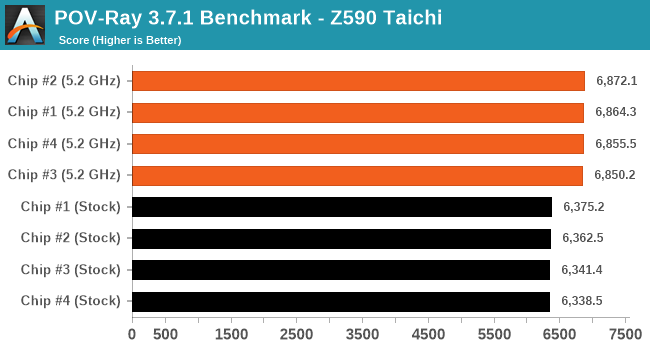

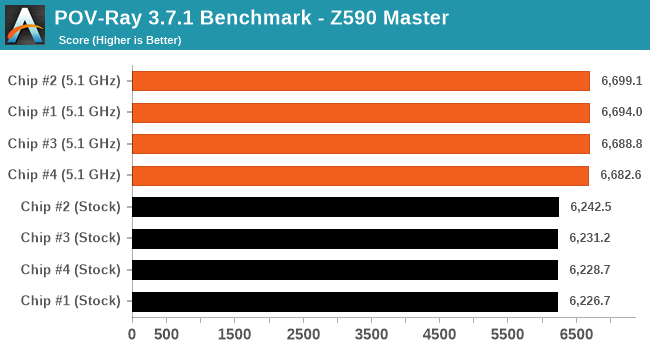
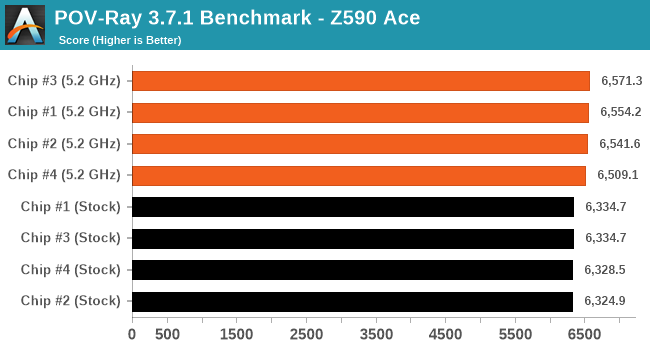
In our POV-Ray testing, all four of the processors on each board managed to beat default performance convincingly with an average increase of 6.4%.
Rendering - Cinebench R23: Link
Maxon's real-world and cross-platform Cinebench test suite has been a staple in benchmarking and rendering performance for many years. Its latest installment is the R23 version, which is based on its latest 23 code which uses updated compilers. It acts as a real-world system benchmark that incorporates common tasks and rendering workloads as opposed to less diverse benchmarks which only take measurements based on certain CPU functions. Cinebench R23 can also measure both single-threaded and multi-threaded performance.
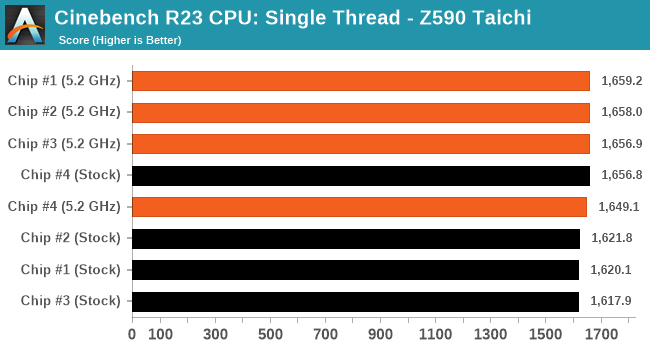
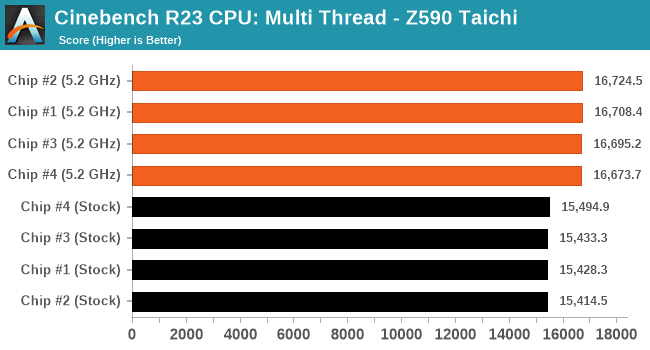
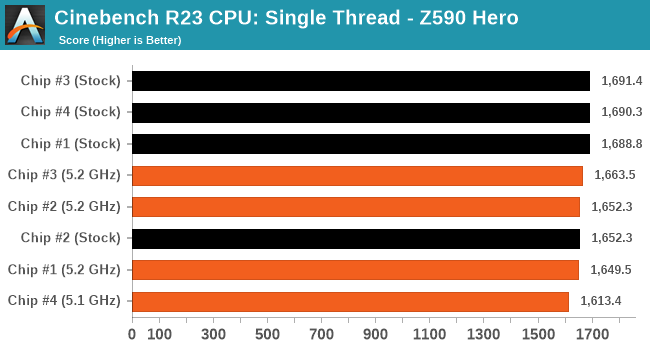
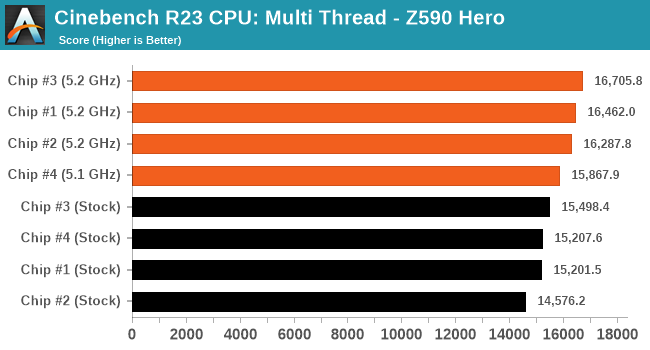
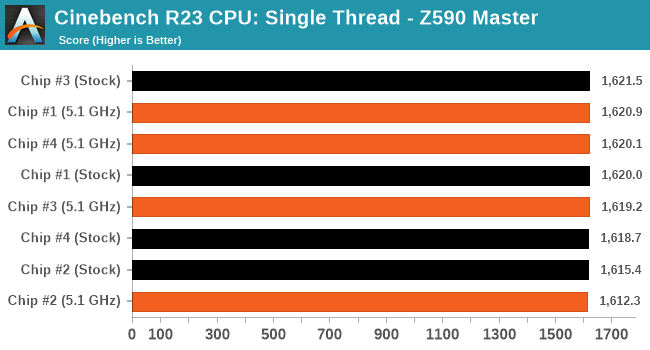
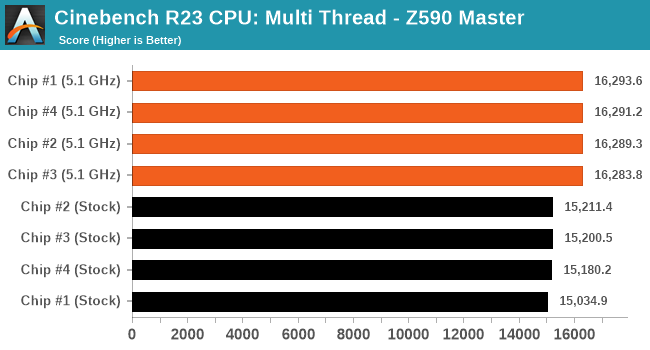
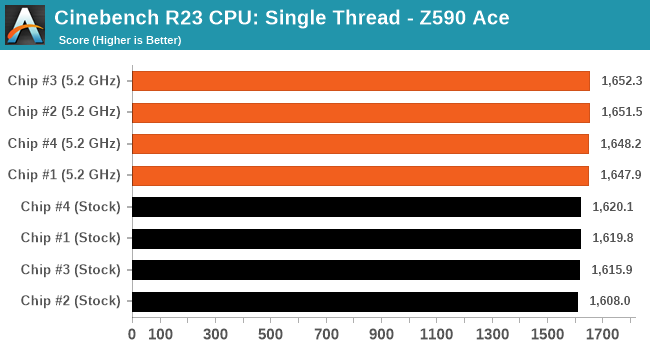

In CineBench R23, we saw a marginal uplift in performance in single-thread performance on average, but the biggest gains were in the multi-thread test with an average increase of 6% over default values. In perspective, the single-threaded performance gains in CB23 were around 0.04%. The reason why the ST values aren't popping here is because the stock CPU enables turbo with TVB to 5.3 GHz, whereas we are fixing each chip to 5.2 GHz all-core.










54 Comments
View All Comments
Samus - Tuesday, August 31, 2021 - link
That's a whole lotta work for a whole lotta nothin'!watzupken - Tuesday, August 31, 2021 - link
424W!!! Goodness me. That is almost like adding Intel's TDP number on top of the 300W that it can potentially pull at full tilt. In my opinion, for the cost of pulling off this overclock, one is better off buying a Ryzen 9 processor. In cases where more core matters, you just can't beat an extra 4 cores on the 5900X or 8 cores on the 5950X.Foeketijn - Tuesday, August 31, 2021 - link
A very long time ago I bought a crate of Socket A Mobile Bartons for peanuts. 6 or so. They could run a 400 fsb instead of their default 266 No locked multipliers (untill 12) .A tiny bit more then the top level Athlon XP. just 75 Watts. And almost double the performance. Quake never went smoother. Those where the days.Oxford Guy - Tuesday, September 7, 2021 - link
Except that they would catch fire, as I recall. No automatic thermal shutdown feature.yeeeeman - Tuesday, August 31, 2021 - link
lets see alder lake 12900k!zodiacfml - Tuesday, August 31, 2021 - link
Great for showing that overlocking is long gone. This is not exclusive to Intel, even AMDs and Nvidia's latest parts have little headroom. One is better of finding a good undervolt with today's latest hardware because it allows longer boosts, lower power consumption, noise, and heat.Wrs - Tuesday, August 31, 2021 - link
All this stuff gets better headroom with better cooling. Unfortunately the TEC here is one of the worst implementations. 88C is the evidence for all that work. The TEC is at least silent. Here it is a TEC combined with liquid cooling. It would be far more effective to use a chiller with plain liquid cooling. Most effective and technically demanding would be phase change refrigeration directly on the CPU IHS.Spunjji - Tuesday, August 31, 2021 - link
TECs are pretty rubbish for this particular purpose, but I think it's the best Intel could do for a "retail" product. It's just a cataclysmically bad idea all-round.Oxford Guy - Tuesday, August 31, 2021 - link
‘Great for showing that overlocking is long gone.’I’ve been saying that for some time and, humorously, someone posted a massive rant in response the last time.
Spunjji - Tuesday, August 31, 2021 - link
Cooling a 400W load with a 200W TEC just seems like a bad idea. It would have been nice to have a more explicit front page heads-up - and maybe more prominence in the wrap-up - that this cooler isn't fit for purpose even with a *stock* CPU.